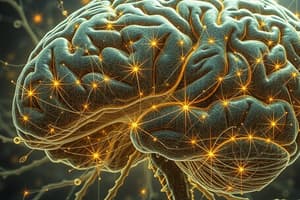Podcast
Questions and Answers
What is the primary function of the dorsolateral corticospinal tract?
What is the primary function of the dorsolateral corticospinal tract?
- Controlling posture
- Movements of the digits (correct)
- Whole-body movements
- Involuntary muscle movements
Which of the following is classified as a direct pathway?
Which of the following is classified as a direct pathway?
- Ventromedial corticorubrospinal tract
- Ventromedial corticobrainstem tract
- Dorsolateral corticospinal tract (correct)
- Dorsolateral corticorubrospinal tract
What characterizes the ventromedial corticobrainstem tract compared to direct pathways?
What characterizes the ventromedial corticobrainstem tract compared to direct pathways?
- It directly influences limb movements
- It controls finer digit movements
- It involves intermediary synaptic connections (correct)
- It does not make synaptic connections
Which type of movement is primarily associated with the ventromedial pathways?
Which type of movement is primarily associated with the ventromedial pathways?
Which statement about the dorsolateral and ventromedial corticospinal tracts is true?
Which statement about the dorsolateral and ventromedial corticospinal tracts is true?
What distinguishes the dorsolateral corticorubrospinal tract from the dorsolateral corticospinal tract?
What distinguishes the dorsolateral corticorubrospinal tract from the dorsolateral corticospinal tract?
What is the primary function of the reflex that shortens a muscle in response to an unexpected increase in its length?
What is the primary function of the reflex that shortens a muscle in response to an unexpected increase in its length?
What is the correct sequence of events in the withdrawal reflex when experiencing sudden pain?
What is the correct sequence of events in the withdrawal reflex when experiencing sudden pain?
What role do inhibitory interneurons play in the withdrawal reflex?
What role do inhibitory interneurons play in the withdrawal reflex?
Which type of reflex involves only one synapse, as described in the content?
Which type of reflex involves only one synapse, as described in the content?
Which type of neurons activate the flexor muscle group in response to painful stimuli?
Which type of neurons activate the flexor muscle group in response to painful stimuli?
What is reciprocation inhibition important for during the withdrawal reflex?
What is reciprocation inhibition important for during the withdrawal reflex?
Which pathway is more involved in activating proximal muscles?
Which pathway is more involved in activating proximal muscles?
What process is responsible for breaking down acetylcholine in the neuromuscular junction?
What process is responsible for breaking down acetylcholine in the neuromuscular junction?
How do dorsolateral pathways differ from ventromedial pathways?
How do dorsolateral pathways differ from ventromedial pathways?
What is a feature of a motor unit?
What is a feature of a motor unit?
What is the primary function of Golgi tendon organs?
What is the primary function of Golgi tendon organs?
What type of muscle contraction do agonist and antagonist muscles create when activated together?
What type of muscle contraction do agonist and antagonist muscles create when activated together?
What initiates the stretch reflex?
What initiates the stretch reflex?
What is the composition of a neuromuscular junction?
What is the composition of a neuromuscular junction?
Which statement about spinal sensorimotor circuits is true?
Which statement about spinal sensorimotor circuits is true?
What is the function of a motor pool?
What is the function of a motor pool?
What is a primary characteristic of the dorsolateral pathways?
What is a primary characteristic of the dorsolateral pathways?
Which statement correctly describes the direct pathways?
Which statement correctly describes the direct pathways?
What defines the ventromedial pathways in contrast to dorsolateral pathways?
What defines the ventromedial pathways in contrast to dorsolateral pathways?
Which of the following is true about the dorsolateral corticorubrospinal tract?
Which of the following is true about the dorsolateral corticorubrospinal tract?
Which pathway is involved in controlling muscles responsible for maintaining posture?
Which pathway is involved in controlling muscles responsible for maintaining posture?
Which feature differentiates indirect pathways from direct pathways?
Which feature differentiates indirect pathways from direct pathways?
What is the primary function of the reciprocal inhibition during the withdrawal reflex?
What is the primary function of the reciprocal inhibition during the withdrawal reflex?
Which part of the nervous system primarily mediates the monosynaptic reflex?
Which part of the nervous system primarily mediates the monosynaptic reflex?
What initiates the withdrawal reflex when experiencing sudden pain?
What initiates the withdrawal reflex when experiencing sudden pain?
How many synapses are involved in the monosynaptic reflex?
How many synapses are involved in the monosynaptic reflex?
What role do excitatory interneurons play in the withdrawal reflex?
What role do excitatory interneurons play in the withdrawal reflex?
What type of reflex is described involving multiple synapses and more complex processing?
What type of reflex is described involving multiple synapses and more complex processing?
Which pathways make synaptic contacts bilaterally and at multiple spinal levels?
Which pathways make synaptic contacts bilaterally and at multiple spinal levels?
What triggers muscle contraction at the neuromuscular junction?
What triggers muscle contraction at the neuromuscular junction?
Which type of muscle contraction occurs when synergist muscles are activated together?
Which type of muscle contraction occurs when synergist muscles are activated together?
What type of muscle receptors are involved in sensing an increase in muscle tension?
What type of muscle receptors are involved in sensing an increase in muscle tension?
What is a characteristic of the dorsolateral pathways?
What is a characteristic of the dorsolateral pathways?
How is acetylcholine typically deactivated at the neuromuscular junction?
How is acetylcholine typically deactivated at the neuromuscular junction?
What are the two processes involved in deactivating acetylcholine?
What are the two processes involved in deactivating acetylcholine?
Which circuit involves a disynaptic connection for muscle tension regulation?
Which circuit involves a disynaptic connection for muscle tension regulation?
What is the function of the motor unit?
What is the function of the motor unit?
What is the role of spindle fibers in muscle activity?
What is the role of spindle fibers in muscle activity?
Flashcards are hidden until you start studying
Study Notes
Descending Motor Pathways
-
Two primary pathways originate from the brain: dorsolateral and ventromedial.
-
Dorsolateral Pathways: Involved in limb and digit movements.
- Dorsolateral Corticospinal Tract: Controls digit movements.
- Dorsolateral Corticorubrospinal Tract: Also influences limb movements.
-
Ventromedial Pathways: Regulate posture and whole-body movements; affect proximal limb muscles.
- Ventromedial Corticospinal Tract: Affects postural control.
- Ventromedial Corticobrainstem Tract: Influences muscle coordination for posture.
-
Direct Pathways: Dorsolateral and ventromedial corticospinal tracts reach the spinal cord without intermediary synapses.
-
Indirect Pathways: Ventromedial corticobrainstem and dorsolateral corticorubrospinal tracts form synapses with intermediary structures before reaching the spinal cord.
-
Synaptic Connection Differences:
- Ventromedial pathways have a more diffused synaptic connection, impacting multiple spinal levels and bilateral interneurons.
- Dorsolateral pathways make more focused synaptic contacts, typically influencing a single motor neuron at one spinal level.
-
Muscle Activation:
- Dorsolateral pathways primarily target distal limb and digit muscles.
- Ventromedial pathways predominantly activate proximal muscles and trunk musculature.
Neuromuscular Junction
-
Defined as the synaptic contact point between a motor neuron and a muscle fiber.
-
Muscles connect to bones via tendons; the motor end plate is part of the postsynaptic membrane.
-
Muscle contraction process:
- Motor neuron releases acetylcholine (ACh).
- ACh binds to receptors, causing sodium influx and subsequent action potential.
- This initiates a series of events that lead to muscle fiber contraction.
-
Muscle relaxation requires deactivation of ACh through:
- Enzymatic degradation by acetylcholinesterase.
- Enzymatic reuptake by the presynaptic terminal.
-
Motor Unit: A motor neuron and all the muscle fibers it activates. The size varies based on functional demand.
-
Motor Pool: Collection of motor neurons that innervate a single muscle group; multiple motor units are involved in muscle activation.
Muscle Types
- Synergist Muscles: Different muscle groups working together to produce the same movement.
- Antagonist Muscles: Muscle groups that produce opposing actions when activated together (e.g., biceps vs. triceps).
Spinal Sensorimotor Circuits
-
Engage in reflex actions; require receptors in muscles and tendons.
-
Types of Reflex Circuits:
-
Golgi Tendon Reflex:
- Involves golgi tendon organs located in tendons.
- Senses muscle tension, activates inhibitory interneurons for safety, preventing tissue damage (disynaptic connection).
-
Stretch Reflex:
- Uses spindle fibers within the muscle to sense sudden length changes.
- Activates motor neurons to contract the lengthened muscle (monosynaptic reflex).
-
Withdrawal Reflex:
- Activated by free nerve endings detecting pain.
- Functions to pull the body away from painful stimuli via an excitatory interneuron activating the flexor motor neuron.
- Simultaneously, an inhibitory interneuron reduces the tension in the antagonistic muscle, allowing for effective movement (reciprocal inhibition, polysynaptic reflex).
-
Descending Motor Pathways
-
Two primary pathways originate from the brain: dorsolateral and ventromedial.
-
Dorsolateral Pathways: Involved in limb and digit movements.
- Dorsolateral Corticospinal Tract: Controls digit movements.
- Dorsolateral Corticorubrospinal Tract: Also influences limb movements.
-
Ventromedial Pathways: Regulate posture and whole-body movements; affect proximal limb muscles.
- Ventromedial Corticospinal Tract: Affects postural control.
- Ventromedial Corticobrainstem Tract: Influences muscle coordination for posture.
-
Direct Pathways: Dorsolateral and ventromedial corticospinal tracts reach the spinal cord without intermediary synapses.
-
Indirect Pathways: Ventromedial corticobrainstem and dorsolateral corticorubrospinal tracts form synapses with intermediary structures before reaching the spinal cord.
-
Synaptic Connection Differences:
- Ventromedial pathways have a more diffused synaptic connection, impacting multiple spinal levels and bilateral interneurons.
- Dorsolateral pathways make more focused synaptic contacts, typically influencing a single motor neuron at one spinal level.
-
Muscle Activation:
- Dorsolateral pathways primarily target distal limb and digit muscles.
- Ventromedial pathways predominantly activate proximal muscles and trunk musculature.
Neuromuscular Junction
-
Defined as the synaptic contact point between a motor neuron and a muscle fiber.
-
Muscles connect to bones via tendons; the motor end plate is part of the postsynaptic membrane.
-
Muscle contraction process:
- Motor neuron releases acetylcholine (ACh).
- ACh binds to receptors, causing sodium influx and subsequent action potential.
- This initiates a series of events that lead to muscle fiber contraction.
-
Muscle relaxation requires deactivation of ACh through:
- Enzymatic degradation by acetylcholinesterase.
- Enzymatic reuptake by the presynaptic terminal.
-
Motor Unit: A motor neuron and all the muscle fibers it activates. The size varies based on functional demand.
-
Motor Pool: Collection of motor neurons that innervate a single muscle group; multiple motor units are involved in muscle activation.
Muscle Types
- Synergist Muscles: Different muscle groups working together to produce the same movement.
- Antagonist Muscles: Muscle groups that produce opposing actions when activated together (e.g., biceps vs. triceps).
Spinal Sensorimotor Circuits
-
Engage in reflex actions; require receptors in muscles and tendons.
-
Types of Reflex Circuits:
-
Golgi Tendon Reflex:
- Involves golgi tendon organs located in tendons.
- Senses muscle tension, activates inhibitory interneurons for safety, preventing tissue damage (disynaptic connection).
-
Stretch Reflex:
- Uses spindle fibers within the muscle to sense sudden length changes.
- Activates motor neurons to contract the lengthened muscle (monosynaptic reflex).
-
Withdrawal Reflex:
- Activated by free nerve endings detecting pain.
- Functions to pull the body away from painful stimuli via an excitatory interneuron activating the flexor motor neuron.
- Simultaneously, an inhibitory interneuron reduces the tension in the antagonistic muscle, allowing for effective movement (reciprocal inhibition, polysynaptic reflex).
-
Studying That Suits You
Use AI to generate personalized quizzes and flashcards to suit your learning preferences.



